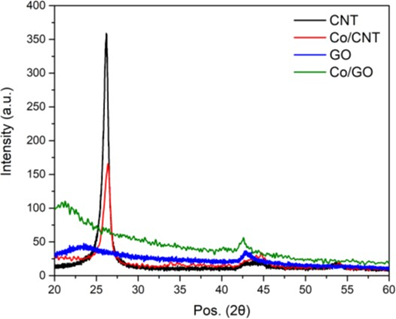Evaluación del óxido de grafeno depositado en nanopartículas de cobalto y soportes de nanotubos de carbono como electrodos supercondensadores
DOI:
https://doi.org/10.37636/recit.v214044Palabras clave:
Supercondensador, Óxido de Grafeno, Nanotubos de Carbono, Nanopartículas de Cobalto.Resumen
Las nanopartículas de cobalto se depositaron en soportes de carbono, nanotubos de carbono de pared múltiple (CNT) y óxido de grafeno (GO), y se evaluaron como potenciales electrodos de supercondensadores. La estructura y la morfología de las nanopartículas de cobalto depositadas sobre los soportes de carbono se estudiaron mediante XRD, TGA y espectroscopía Raman. La voltametría cíclica se utilizó para medir la carga eléctrica del electrodo en función de los materiales y se calculó su capacitancia específica (Csp). El electrodo basado en GO mostró un Csp mayor que el electrodo CNT, lo cual se atribuye a un área de superficie mayor del soporte de carbono GO. Curiosamente, el depósito de nanopartículas de Co promovió una Csp mejorada en los soportes GO y en los CNT de pared múltiple.Descargas
Citas
M. Vangari, T. Pryor, and L. Jiang, "Supercapacitors: Review of materials and fabrication methods," J. Energy Eng., vol. 139, no. 2, pp. 72-79, 2013. https://doi.org/10.1061/(ASCE)EY.1943-7897.0000102 DOI: https://doi.org/10.1061/(ASCE)EY.1943-7897.0000102
C. Zhao and W. Zheng, "A Review for Aqueous Electrochemical Supercapacitors," Front. Energy Res., vol. 3, no. May, pp. 1-11, 2015. https://doi.org/10.3389/fenrg.2015.00023 DOI: https://doi.org/10.3389/fenrg.2015.00023
Z. Fan, J. Chen, K. Cui, F. Sun, Y. Xu, and Y. Kuang, "Preparation and capacitive properties of cobalt-nickel oxides/carbon nanotube composites," Electrochim. Acta, vol. 52, no. 9, pp. 2959-2965, 2007. https://doi.org/10.1016/j.electacta.2006.09.029 DOI: https://doi.org/10.1016/j.electacta.2006.09.029
W. Chen, L. Yan, and P. R. Bangal, "Preparation of graphene by the rapid and mild thermal reduction of graphene oxide induced by microwaves," Carbon N. Y., vol. 48, no. 4, pp. 1146- 1152, 2010. https://doi.org/10.1016/j.carbon.2009.11.037 DOI: https://doi.org/10.1016/j.carbon.2009.11.037
A. Aguilar-Elguézabal, W. Antúnez, G. Alonso, F. P. Delgado, F. Espinosa, and M. Miki- Yoshida, "Study of carbon nanotubes synthesis by spray pyrolysis and model of growth," Diam. Relat. Mater., vol. 15, no. 9, pp. 1329-1335, 2006. https://doi.org/10.1016/j.diamond.2005.10.011 DOI: https://doi.org/10.1016/j.diamond.2005.10.011
M. Beltrán Gastélum, "Síntesis y caracterización de electrocatalizadores nanoestructurados y su aplicación en celdas de combustible a escala prototipo," Instituto Tecnológico de Tijuana, 2016.
S. Perumbilavil, P. Sankar, T. Priya Rose, and R. Philip, "White light Z-scan measurements of ultrafast optical nonlinearity in reduced graphene oxide nanosheets in the 400-700 nm region," Appl. Phys. Lett., vol. 107, no. 5, pp. 10-15, 2015. https://doi.org/10.1063/1.4928124 DOI: https://doi.org/10.1063/1.4928124
M. A. Atieh, O. Y. Bakather, B. Al- Tawbini, A. A. Bukhari, F. A. Abuilaiwi, and M. B. Fettouhi, "Characterization of carbon nanotubes by Raman spectroscopy," Bioinorg. Chem. Appl., vol. 2010, no. 2, pp. 1-9, 2010. https://doi.org/10.1155/2010/603978 DOI: https://doi.org/10.1155/2010/603978
T. A. Saleh, The Role of Carbon Nanotubes in Enhancement of Photocatalysis, in Syntheses and Applications of Carbon Nanotubes and Their Composites, S. Suzuki, Ed. Rijeka: InTech, 2013. https://doi.org/10.5772/51050 DOI: https://doi.org/10.5772/51050
V. V. Brus, A. K. K. Kyaw, P. D. Maryanchuk, and J. Zhang, "Quantifying interface states and bulk defects in high-efficiency solution- processed small-molecule solar cells by impedance and capacitance characteristics," Prog. Photovoltaics Res. Appl., vol. 23, no. 11, pp. 1526- 1535, Nov. 2015. https://doi.org/10.1002/pip.2586 DOI: https://doi.org/10.1002/pip.2586

Descargas
Publicado
Cómo citar
Número
Sección
Categorías
Licencia
Derechos de autor 2019 David Ricardo Aguilar-Meza, Moisés Israel Salazar-Gastélum, Sergio Pérez-Sicairos, Rosa María Félix-Navarro, Yadira Gochi-Ponce

Esta obra está bajo una licencia internacional Creative Commons Atribución 4.0.
Los autores/as que publiquen en esta revista aceptan las siguientes condiciones:
- Los autores/as conservan los derechos de autor y ceden a la revista el derecho de la primera publicación, con el trabajo registrado con la licencia de atribución de Creative Commons 4.0, que permite a terceros utilizar lo publicado siempre que mencionen la autoría del trabajo y a la primera publicación en esta revista.
- Los autores/as pueden realizar otros acuerdos contractuales independientes y adicionales para la distribución no exclusiva de la versión del artículo publicado en esta revista (p. ej., incluirlo en un repositorio institucional o publicarlo en un libro) siempre que indiquen claramente que el trabajo se publicó por primera vez en esta revista.
- Se permite y recomienda a los autores/as a compartir su trabajo en línea (por ejemplo: en repositorios institucionales o páginas web personales) antes y durante el proceso de envío del manuscrito, ya que puede conducir a intercambios productivos, a una mayor y más rápida citación del trabajo publicado (vea The Effect of Open Access).











